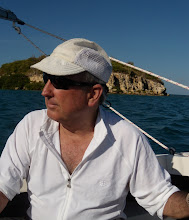The good news is that an off-shore boat is made to float like a cork in the most menacing conditions, and modern technology makes off-shore sailing much, much easier and safer than even ten years ago.
My Flicka, like any competent off-shore sailboat, has a keel of sufficient weight (1,800 pounds) so that even if rolled upside down she will right herself much like those inflatable clowns with the sand in the bottom. The companionway leading from the cockpit to the cabin can be boarded up in rough weather so that the cabin is essentially water-tight. The boat could be completely submerged in a wave and the boards would keep all but a trickle of the water out. When the wave passes, the boat rights herself, and water in the cockpit will quickly drain out the scuppers.
The Flicka is way overbuilt for a boat her size. Who would guess that her 20-foot length would weight 6,000 pounds before loading her with people and supplies? The rigging is the same is would be typical for a sailboat in the 40 to 50-foot range. The 30-foot mast, with its rigging, weighs nearly 175 pounds and is held up by nine (yep, 9) stays: 2 back stays, 6 side stays, and 1 forestay.
Safety at sea in Jubilee is my #1 priority. Following are just some of the steps I am taking to mitigate the risks:
- Storm preparation: I plan to engage a land-based weather and course advisor. These folks will track our progress and through a daily communication, will advise of weather developments forecast for our area and make suggesations when appropriate for altering course to avoid the worst of the developing storms. second, I plan to shorten sail early in anticipation of rough weather. The Flicka has two reefs on the mainsail and one on the jib. If it looks like it will be too rough for the reefed main and jib, we can put up the storm trisail (small main) and storm jib. In the worst conditions we can heave to and deploy a sea anchor (looks like a parachute that drags in the sea) and clip on a stern line to balance the boat at about a 40 degree angle to the wind and waves. This has an amazingly calming effect on the incoming seas and is a tried and true way of riding out a storm. If the storm is blowing from a direction that helps us on our course, we'll deploy a drogue instead of the sea anchor (my drogue is like a small sea anchor) and sail downwind. The purpose of the drogue, which is deployed astern, is to slow the boat, keep the sterrn pointed into the oncomeing waves, and prevent the boat from running down a wave so fast that it puitch-poles (summer-saults) end over end.
- Falling off the boat: We will always be "clipped on" when outside the cabin. What this means is that our inflatable life jackets, which are worn at all times outside the cabin, have built-in harnesses, and the harness will be attached to "jack-lines" (nylon webbing) that runs the length of the boat from the boat to the stern. A six-foot tether connects the harness to the jack lines. If one of us goes overboard, the tethered harness should keep us with the boat until we can climb back on board. We will also practice Man Overboard (MOB) rescue procedures.
- Collisions at Sea: Collisions are rare but can be a disaster if it happens. We will be sailing in some busy shipping lanes, at night and in fog. We are taking many precautions. First (aside from being on watch and scanning the horizon continually) we have radar. Mine is a Furuno 1623, mounted on the port back stay, facing aft on a Waltz gimbol. This radar can see about 16 miles and will be on at night and in foggy conditions. It can be set to sleep most of the time to minimize poer consumption but to awake for a scan every 5 or 10, or 15 minutes. It will emit an audible sound if it sees something on a scan. Second, we will have an Automatic Identification System (AIS) transponder that will be programmed to constantly send out our identity, including our speed and bearing to any other vessel in the area. It also will receive and plot on our GPS screen the identity of any other vessel in the area and show their speed and bearing. If there is a possibility of a collision it emits an audible and shows on the screen where it might happen. This is a new thing in recent years, but all commercial vessels are required to have this equipment functioning. It is a huge improvement in safety. Third, I have installed a tri-color light at the top of the mast whch is much more visible to ships than the standard navigations lights on the hull. We will also hoist up a radar reflector that will definitely make us visible to anyone with radar. Finally, we have a ship's bell and a fog horn to use in the fog.
- Illness: Sea sickness can be expected in rough weather, and I will have tablets (and a bucket) for that. Colds and the flu are rare since there is no one around to give you the bug. The most serious kind of illness would be a severe injury or heart attack. In a seriously life-threatening situation we will call for help wherever we are. For less serious injury we will have standard first aid and splints to stabilize broken bones. We will never expect to be more than 5 days from shore.
